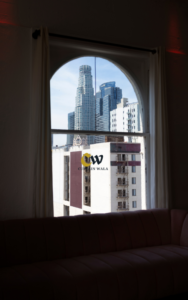
Curtains lift the ambiance of any room. They provide a decorative function and serve a practical purpose in controlling the intensity of light and enhancing privacy. Very important for places such as bedrooms and home theaters where sunlight needs to be controlled, blackout curtains are a must. However, not all curtains have blackout lining built into them. This may leave you seeking a solution to block light without completely replacing your existing curtains. The good news, however, is that you can attach blackout lining to your curtains without sewing. This method is simple, effective, and a budget-friendly alternative for those who aren’t adept with a sewing machine.
We shall here guide you step by step on how to attach blackout lining to your already available existing curtains without stitching. Whether you need to protect furniture from sun damage, save energy money by cutting down the daylight amount entering your house through windows, or just sleep well because of the lack of proper darkness inside your room, this method has been particularly designed for you.
Why Add Blackout Lining?
Let’s begin with the process but first understand why putting in blackout lining is an excellent idea:
- Better Sleep: If you stay in an area with flashing street lights or bright morning sun, blackout curtains may block this light and create just the right sleep environment.
- Energy Efficiency: Blackout linings help to insulate your home, meaning you don’t need to cool it down during summers or warm it up during winters.
- Privacy: These linings ensure increased privacy since one cannot see inside your home, especially during nighttime when the lights are on.
- Sun protection: The blackout linings protect your furniture, floors, and walls against sun damage and fading and discoloration.
- Versatility: If you like the look of the curtains already in place but wish they were more functional, attaching a blackout lining is an excellent solution.
Materials You’ll Need
To attach blackout lining without sewing, you’ll need the following items:
- Blackout lining fabric: They are available in different colors and thickness. Select one that matches your existing curtains.

blackout lining - Fabric tape: Known as fusible bonding tape or iron-on hemming tape. It will stick the lining to your curtain.
- Iron: To work the adhesive in the fabric tape
- Curtain rings with clips: These will attach the lining and the curtain together at the top.
- Measuring tape: To measure accurately.
- Scissors: for cuts of fabrics and tapes.
Step-by-Step Guide to Attaching Blackout Lining
Step 1: Measure Your Curtains
Before buying your blackout lining fabric, take the appropriate measurements of the curtains that you have. Take the width and height of each curtain panel. You need to add a few inches in height of your lining so that it overlaps a bit at the curtain bottom so that you might not see edges of layers after all. This rule of thumb is to ensure it is 2-4 inches narrower and 1-2 inches shorter than the curtain itself to fit well behind the curtain.
Step 2: Cut the Blackout Lining Fabric
Now that you have those measurements, you will cut the blackout lining fabric to measure. Allow cuts straight and flush; cut a little extra because it saves you in case you need adjustments later.
Step 3: Attach the Lining with Fabric Tape
Place the curtain on a flat work surface with its face down and then position the blackout lining alongside it, aligning edges at top so that they are level. Fix fabric tape along the sides and the bottom of the blackout lining to the curtain to glue them together.
- Cut the fabric tape into long strips which almost resemble the width of the curtain and lining.
- Place the tape between the curtain and the lining at the edge.
- To activate the adhesive, use a hot iron and press on the tape-on film; however, be sure to follow the instructions accompanying the tape on temperature and time.

Step 4: Secure the Top with Curtain Rings
The sides and the bottom are now solid, but the top should be secured with some minor reinforcement. That is where the curtain rings with clips will be needed. Use the curtain rings with clips to clip together the blackout lining and the curtain at the top, spreading the rings out evenly down the width of the curtain.
The curtain rings will function as well as decorate, and once assembled, provide a clean and professional-looking finish. Furthermore, since you are using rings and not bonding the lining to the top, it is then easy to remove the lining in case you want to replace it or wash them separately.
Step 5: Hang Your Curtains
Once the blackout lining is stuck in place, hang your curtains back up on the curtain rod with some precise adjustments to ensure it is pretty aligned with your curtain and one last adjustment to ensure that the fabric tape has bonded perfectly. The outcome would then be a beautiful functional blackout curtain that will shut light out and provide more seclusion.
Advantages of No-Sew Methods
There are few advantages to opt for a no-sew technique:
- Time-Saving: Since you are not supposed to sew, it would save more time than sewing up for a person who intends to enhance the decor of curtains.
- No Extra Abilities Required: Whether you know how to stitch or not, following this method is quite effortless with just basic tools like fabric tape along with the curtains and rings.
- Removable Lining: This blackout lining can be removed and therefore can also be removed/replaced if one decides to change to different options of linings. It is, therefore, a quite versatile solution.
- No Damage to Curtains: Since no needle and thread are used in this method, the previously made curtains will not be damaged. This is an excellent option in case you have delicate or costly curtains.
Alternative No-Sew Methods

Apart from the technique involving fabric tape and curtain ring, there are still innovative ways to fix the blackout lining without sewing:
- Velcro Strips: You can use Velcro as an attachment for your lining to the curtains. Fix strips of adhesive-backed Velcro onthe top edge of your curtain and the blackout lining then press them together. This allows you to change them easily for cleaning and is a no-sew technique.
- Magnetic Strips: Small magnets can be sewn on the edges of the blackout lining and the curtain so they can pull together. It’s quite flexible as the magnets are easy to remove or to replace at will.
Final Touches
Once you’ve attached the blackout lining to your curtains, you might notice some wrinkles or creases. To smooth these out, use a steam iron or a steamer, but be sure to check the care instructions for both the lining and the curtain fabric before applying heat.
For an even more tailored look, consider adding tiebacks or curtain hooks to help manage the flow of your curtains and keep them looking neat during the day.
FAQs:
-
How do you attach blackout lining to existing curtains?
The no-sew method allows you to attach blackout lining with your existing curtains through the application of fabric tape, curtain rings with clips, or Velcro strips. You start by determining the measurement and size of the blackout lining with respect to your curtain size. You then attach the edges of the lining with the curtain using the fabric tape. Finally, you lock the top end with the curtain ring including the clips or Velcro to let the blackout lining hang snugly behind your curtain.
-
How to make curtains blackout without sewing?
For instance, you can also make your curtains blackout without sewing: Just attach the blackout lining to the back of the curtain using fabric tape or adhesive Velcro strips. You could even use clips on curtain rings at the top for this purpose. All these are ways with which you could add a blackout effect to your curtains with little effort.
-
How to hang blackout curtains behind curtains?
Hang blackout curtains behind existing ones simply by using a double curtain rod setup, where the blackout curtain is attached to the back rod and the decorative curtain hangs on the front rod. You can also forgo the double rod setup and attach blackout lining directly to your existing curtain using clips or fabric tape that drapes discreetly behind it.
-
Does hemming tape work on blackout curtains?
You can use hemming tape. Hemming tape is sometimes called fabric tape or fusible bonding tape. It is a no-sew solution that consists of heating the tape to join two pieces of fabric together. How you do it: You apply the tape between the blackout lining and the curtain. Then, you use an iron to activate the adhesive, pressing down on the fabric. You need to check the care instructions because too much heat could damage certain types of blackout fabric.




Pingback: Which Are the Best Blackout Curtains: One Shot Guide